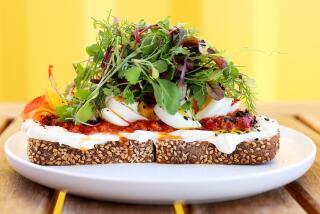What Budapest Offers for Lunch or Dinner
- Share via
BUDAPEST, Hungary — Coffee and pastries are all very well and good for the morning or midafternoon, but when it’s time for lunch or dinner, Budapest has considerably more to offer. Here are four possibilities:
The popular 1904-vintage Matyas Pince, for instance, serves an excellent, authentic gulyas or goulash soup--not at all the dense, sour-cream-thickened stew most Americans might expect, but a bowl-size cup of long-cooked beef with potatoes and onions in very flavorful dark-brown broth (with, for lovers of spice, a bowl of wonderful hot red chili paste on the side).
Other specialties include such tongue-twisters as ponty finomfalatok , small pieces of surprisingly light fried carp over a mound of plain rice, scattered with pickled morello cherries, with cabbage salad on the side; Bekesszentandrasi sertesermek or Bekesszentandras-style pork medallions, in a sauce of sweet red peppers, tomatoes and sausage, with steamed potatoes and little curly noodles on the side, and korozott paprikaba toltve, a sweet red pepper stuffed with slightly sourish ewe’s cheese, eaten as an after-dinner cheese course.
Adding to the Hungarian flavor at Matyas Pince are the elaborate frescoes, carved wood and leaded-glass windows by turn-of-the-century artists Jeno Haranghy and Gyula Bozo; the rousing Hungarian music by members of the Lakatos “Gypsy Dynasty,” and the potent but thankfully small house-special cocktail, the Puszta, made from cherry wine and apricot brandy.
Gundel, which opened in Budapest’s City Park in 1910, was one of the grand old restaurants of the city’s golden age--its Maxim’s, or at least its Chasen’s.
It was recently announced that Hungarian-born American restaurant consultant George Lang has been engaged to revivify the place and return it to a semblance of its former splendor.
In the meantime, it is worth sampling for its lovely garden terrace, which manages to evoke, at least faintly, the insouciance and cosmopolitan flair of Old Budapest--particularly if your eye can filter out the yellow Camel cigarette umbrellas and the tacky makeshift canopies, pavilions and space dividers that obscure the handsome architecture of the main building.
The food, alas, is unmemorable: wild strawberry soup tastes extremely tame, Gundel-style fogas (pike-perch, Hungary’s most famous and delicious fish) in a spongy egg batter with frozen peas and a heavy cream sauce, dried-out turkey breast with Roquefort (which has surely never seen France) and such. One high point on the menu, though, is the sajttorta zold hagymaval, another after-meal cheese concoction consisting of layers of mild, firm yellow-white cheese with paprika-spiked cream cheese between them, served with toast and a garnish of extraordinarily flavorful tomatoes (at least in summer)--a vegetable, incidentally, which goes by the charming Hungarian name paradiscom .
Near the Forum, the Duna-InterContinental and other posh hotels, and a few steps from the Vaci Utca, Budapest’s upwardly-mobile pedestrian shopping street (where short-haired teen-agers in black T-shirts and jeans mingle on the sidewalk outside the Adidas shop with wizened farm women hawking hand-embroidered shawls and skirts) is Szazeves, or the Hundred Year Restaurant.
In fact, it’s older than that. A plaque on the wall notes that the structure itself dates from 1756, and that these walls have housed a restaurant continuously since 1831. The interior--full of carved wood, raw stone and decorative tiles--seems genuine and not at all self-consciously folksy, and the awning-covered terrace is absolutely enchanting--like something you’d expect to find in Rome or Venice. The food is unpretentious and hearty--excellent Hungarian salami with crusty bread and creamy butter, fried goose liver in a light breading (this being a great local specialty--to the point that much of the foie gras sold in France today is Hungarian in origin), carp sauteed with peppers and onions, wild game in season and the like.
Speaking of Rome or Venice, though, the most surprising restaurant in Budapest today, and certainly the best by international standards, is Marco Polo, on the edge of Vorosmarty Square near the Vigado concert hall.
As its name suggests, it is an Italian restaurant run by a man named Oreste Beghetto, of Trieste, in partnership with the Hungarian government restaurant association.
A genuinely stylish restaurant that would not look out of place in Manhattan or Santa Monica--with its blond-wood-and-pastel interior, Italian alta moda light fixtures and opulent table settings (beige and white linens, exquisite thin crystal and Ginori-like Hungarian Herend china)--Marco Polo offers light, contemporary Italian fare based largely on ingredients imported in twice-weekly shipments from Italy itself.
The steak-tartare-like battuto of fresh tuna atop slices of delicious fried eggplant, the crab meat and salt cod salad, the seafood risotto, the pan-fried chicken breast with garlic sauce and a veritable garden of fresh vegetables and such--not to mention the homemade bread sticks, the small but good selection of Italian wines and what is quite possibly the best coffee in town (all those coffeehouses notwithstanding)--are so unexpected in the middle of Budapest, and so radically un-Hungarian in heft and texture, as to seem downright extraordinary after a few days of more traditional local dining.
Note: Restaurant prices in Hungary tend to reflect the costs of raw materials, with such items as goose liver and imported fish costing considerably more than, say, locally made sausage or Hungarian pork dishes--thus the broad range of prices quoted below. In reality, if the diner avoids obvious delicacies or imports and sticks to local fare, something closer to the lower tariffs will prevail. Prices that follow are for a three-course dinner for two with Hungarian wine, and are approximate.
Matyas Pince, Marcius 15 Ter 7, local telephone 1181-693 or 1181-650; $30-$70. Gundel Restaurant, Allatkerti Utca 2, 1221-002 or 1213-550; $20-$70. Szazeves, Pesti Barnabas Utca 2, 1183-608; $20-$80. Marco Polo, Vigado Ter 3, 1383-354 or 1383-925; $40-$90.
More to Read
Eat your way across L.A.
Get our weekly Tasting Notes newsletter for reviews, news and more.
You may occasionally receive promotional content from the Los Angeles Times.










